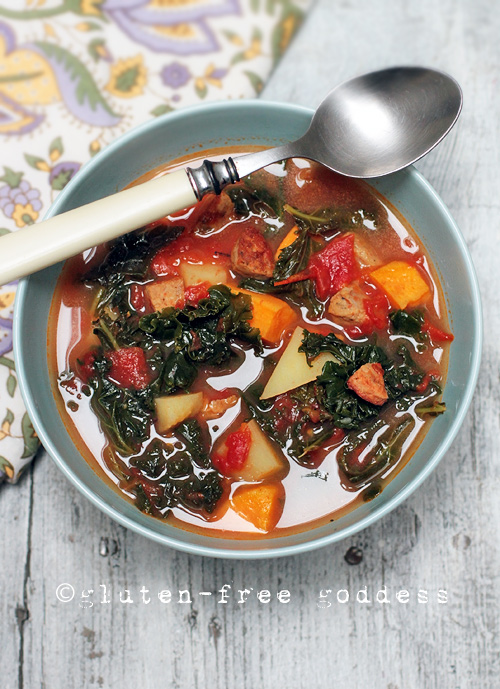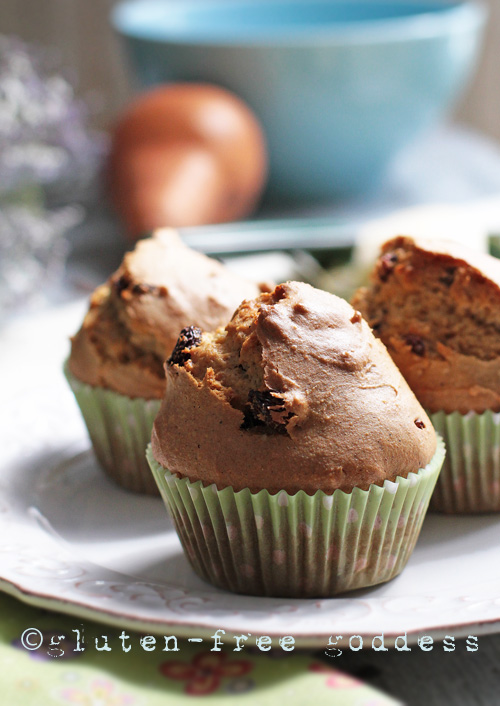The Gluten-Free Diet Cheat-Sheet: How to Go G-Free
New to gluten-free living?
Here's a printable quick start guide on how to begin a gluten-free diet.Karina's Gluten-Free Cheat Sheet
by Karina Allrich
Foods to avoid on a gluten-free diet:
Gluten is the elastic protein found in wheat, rye, and barley (including durum, einkorn, graham, semolina, bulgur wheat, spelt, farro, kamut, and triticale). Commercially produced oats may also contain gluten due to cross contamination in processing (more on gluten-free oats below).
Recipes and products that use wheat flour (bleached or non-bleached white flour, whole wheat flour, cracked wheat, wheat bran, barley flour, semolina, durum, spelt, farro, kamut, triticale) or vital wheat gluten are not gluten-free.
Injera bread (traditionally made from teff flour) and Asian rice wraps may be gluten-free, but are not necessarily gluten-free (check labels, always).
Injera bread (traditionally made from teff flour) and Asian rice wraps may be gluten-free, but are not necessarily gluten-free (check labels, always).
Semolina, durum, spelt and whole wheat pasta, including cous cous, ramen noodles, and some soba noodles, are not gluten-free.
Beer, ale, lager and malted beverages are not gluten-free. Foods cooked in beer- such as brats, meats and sausage, etc- are not gluten-free.
Malt vinegar, malt flavorings and barley malt are not gluten-free.
Recipes and products using breadcrumbs, breaded coatings, fried onion rings, dredged flour coating, bread and flat bread, croutons, bagels, croissants, flour tortillas, pizza crust, graham crackers, granola, cereal, wheat germ, wheat berries, cookie crumbs, pancake mix, pie crust pastry, crackers, pretzels, toast, flour tortillas, sandwich wraps and lavash, or pita bread are not gluten-free.
The vegan protein sub seitan (made with vital wheat gluten) is not gluten-free; and some tempeh is not gluten-free (you must check, especially for soy sauce flavoring). Flavored tofu may or may not be gluten-free due to soy sauce and seasoning.
Barley enzymes used in malt beverages, chocolate chips, coffee and coffee flavors/blended mixes, flavored and herbal teas, dessert syrups, brown rice syrup are not gluten-free. Always check on "natural flavors" as well.
Unfortunately, spices have become a new concern, as many single ground spices and spice blends have tested high in hidden gluten. It is important to use due diligence on the spice issue; call the company and ask if the spice or spice blend you are using has been tested for gluten.
Unfortunately, spices have become a new concern, as many single ground spices and spice blends have tested high in hidden gluten. It is important to use due diligence on the spice issue; call the company and ask if the spice or spice blend you are using has been tested for gluten.
Gluten is sneaky.
Hidden gluten can be found in soy sauce, tamari style stir-fry sauces, marinades, gravy, gravy mixes and gravy packets, broth and bouillon, cooking sauces and instant soups, salad dressings, cured meats, sausage, hot dogs, vegan hot dogs and "fake" meat, sausages and burgers, self-basting poultry, flavored and herb cheeses. Watch for spice blends including curry powder, dry mustard (often combined with flour) and ground spices such as cinnamon or cardamon.
Check labels on canned and prepared soups, tomato paste, sweeteners, confectioner's powdered sugar and brown sugar, prepared beverages, flavored and instant coffees, herbal teas (watch for barley or "natural flavors"), roasted, flavored or spiced nuts, jerky, flavored yogurts, puddings and ice creams, chocolate and chocolate chips, cocoa powder and instant cocoa mixes, flavored vinegars (avoid malt vinegar, and fake "balsamic" flavored vinegar), cooking wines, flavored liqueur and liquor, wine coolers (malt).
Always read labels. Call the manufacturer.
Eating out is very, very risky.
Be aware that delis and restaurants often add flour to thicken soups and sauces, may add pancake mix to egg omelettes, and use breadcrumbs to add 'body' to tuna or chicken salad. Gluten-free pasta might be boiled in the same water used for wheat pasta (and some kitchens blanch fresh veggies in their glutened pasta water). Avoid French fries and fried foods fried in the same oil with wheat flour breaded foods (fried onion rings, batter coated fish, veggies, meat and chicken); ask if the flyer oil is dedicated to gluten-free food only- if not- the oil is not gluten-free.
What is gluten-free?
GLUTEN-FREE FOOD LIST:
Alternative grains, flours, starches and thickeners that appear to be safe for celiac disease, and wheat allergies include:
Non-GMO corn flour, grits, polenta and cornmeal
Buckwheat, buckwheat cereal, kasha and buckwheat flour
Rice- white, brown, risotto, basmati, jasmine, sticky rice (sushi rice), rice flakes/hot cereal
Rice flour- white rice, sweet (glutinous) rice and brown rice flour
Quinoa, quinoa cereal flakes, and quinoa flour
Millet and millet flour
Sorghum flour (also known as jowar)
Amaranth and amaranth flour
Coconut flour
Teff flour
Nut meals and flours- almond, chestnut, pecan, cashew
Chick pea flour, garbanzo flour, soy (soya) and bean flour
Tapioca starch/tapioca flour (aka manioc)
Potato starch (used in baking)
Potato flour (used sparingly as a thickener)
Sweet potato and yam flour
Arrowroot starch
Cornstarch
Chestnut flour
Chestnut flour
*Safe if milled in a dedicated GF facility/source. Check with companies to determine if they are using allergen safety protocols, and a gluten-free facility.
Pre-made ingredients that are usually safe for celiac include:
Non-GMO corn tortillas, chips, and taco shells with a gluten-free label
Pre-made organic polenta rolls with a gluten-free label
Unflavored mochi
100% Corn pasta and corn with rice pasta with a gluten-free label
Quinoa and corn pasta with a gluten-free label
Soy pasta (if it states gluten-free)
Brown and white rice pasta, rice noodles, rice glass noodles with a gluten-free label
100% buckwheat soba noodles (check label)
Rice paper, rice and tapioca rice paper wraps (check label for gluten-free status)
100% nut butters- almond, peanut, cashew, pecan
100% seed butters- sesame tahini, sunflower and hemp seed butter
As always, call the manufacturer to determine cross contamination probability and risk. Some companies (including bakeries, local vendors and restaurants) are not 100% gluten-free, despite sporting a GF label or claim on a menu (frustrating, I know). Call and discuss best manufacturing practices and allergen safety protocols.
We also recommend consuming only Non-GMO corn. Typically, organic corn is Non-GMO; call to make sure.
We also recommend consuming only Non-GMO corn. Typically, organic corn is Non-GMO; call to make sure.
Gluten-Free Goddess cautions readers to re-think the use of gluten-free oats in a gluten-free diet. The latest oats and oatmeal testing by Gluten-Free Watchdog reveals a higher amount of gluten than is acceptable for celiac patients. We no longer use "gluten-free oats" in our kitchen. Do your own research, please, to understand the risks, and make informed choices.
About baking GF recipes:
When it comes to converting your favorite baking recipes to gluten-free, a simple one-to-one flour substitution will not yield the same results as your recipe based on wheat flour. Gluten is a giving, stretchy ingredient that supports rise, structure, texture and kneadablity. It takes more than a single gluten-free flour replacement to make a cake, bread, muffin or cookie recipe work.
A combination of gluten-free flours and starches with xanthan gum added to improve viscosity is necessary for optimum results. If avoiding xanthan gum, try using using flax seed meal.
Just starting out? Try using an all purpose gluten-free baking and pancake mix (one without bean flour). If you are disappointed in the results, you might try the individual gluten-free flours we have come to love (see our recipes).
Too many starches can make a flavorless, gummy product.
A combination of gluten-free flours and starches with xanthan gum added to improve viscosity is necessary for optimum results. If avoiding xanthan gum, try using using flax seed meal.
Just starting out? Try using an all purpose gluten-free baking and pancake mix (one without bean flour). If you are disappointed in the results, you might try the individual gluten-free flours we have come to love (see our recipes).
Too many starches can make a flavorless, gummy product.
Essential gluten-free living posts:
How To Go Gluten-Free- In Detail
Gluten-Free Bread Machine Tips
Gluten-Free Cooking + Baking Tips
Baking + Cooking Substitutions for Food Allergies
Gluten-Free On a Budget
Gluten-Free Diet Cheat Sheet is © 2009-2016 Karina Allrich, Gluten-Free Goddess®. All rights reserved. No reproduction in any media.
Gluten-Free Bread Machine Tips
Gluten-Free Cooking + Baking Tips
Baking + Cooking Substitutions for Food Allergies
Gluten-Free On a Budget
Gluten-Free Diet Cheat Sheet is © 2009-2016 Karina Allrich, Gluten-Free Goddess®. All rights reserved. No reproduction in any media.






